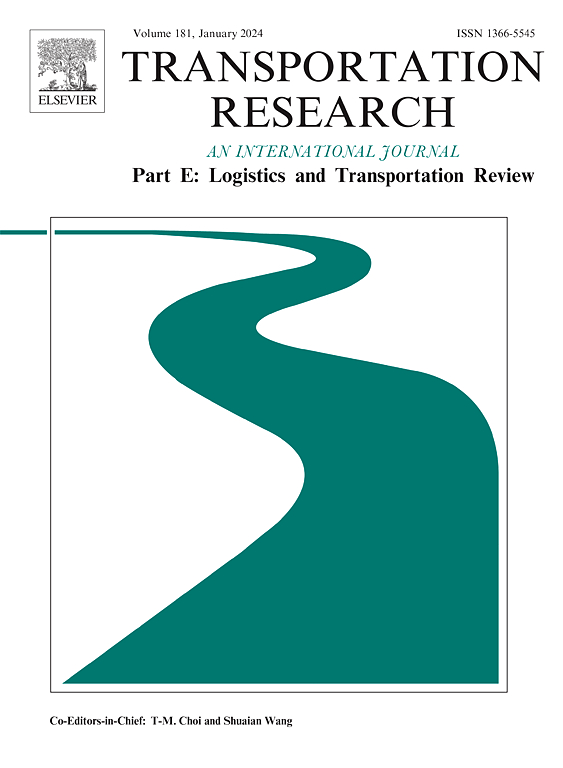Retailer hoarding in emergency situations: A game-theoretic analysis
IF 8.3
1区 工程技术
Q1 ECONOMICS
Transportation Research Part E-Logistics and Transportation Review
Pub Date : 2025-05-25
DOI:10.1016/j.tre.2025.104187
引用次数: 0
Abstract
Despite current policies, retailer hoarding continues to occur frequently during specific emergency situations, highlighting the significance of understanding the underlying mechanism. This study employs Stackelberg game models within a two-tier supply chain consisting of a supplier and a retailer to analyse their decisions during persistent emergencies. The models incorporate the interactions between retailer hoarding, consumer panic buying, and incomplete information regarding future conditions. The equilibrium solutions of the models yield the following findings: First, the retailer’s profit-driven hoarding can not only stem from the anticipation of high future prices, but may also be a consequence of price gouging through withholding goods and intensifying consumer panic at present, while insufficient supply does not necessarily imply this behaviour. Second, even with sufficient supply, consumer panic buying may also prompt the retailer to engage in price gouging by reducing the order quantity, which in turn amplifies consumer panic and exacerbates the challenges within the supply chain. Finally, the negative impact of incomplete information in the supply chain is emphasized. In such cases, both parties are advised to adopt conservative estimates of the future price for profit, which, however, can lead to lower sales and impair consumers. These results enrich the theoretical knowledge of retailer hoarding and elucidate the drivers of this irrational and illegal behaviour. They also provide valuable insights, highlighting the importance for regulators to manage consumer panic buying to reduce retailer hoarding as well as promoting precise information disclosure during emergencies.
紧急情况下零售商囤积:博弈论分析
尽管有现行政策,但在特定的紧急情况下,零售商囤积行为仍然频繁发生,这凸显了了解潜在机制的重要性。本研究在由供应商和零售商组成的两层供应链中采用Stackelberg博弈模型来分析他们在持续紧急情况下的决策。这些模型结合了零售商囤积、消费者恐慌性购买和关于未来情况的不完整信息之间的相互作用。模型的均衡解得出以下结论:首先,零售商利润驱动的囤积行为不仅源于对未来高价格的预期,也可能是通过扣留商品和加剧当前消费者恐慌来哄抬价格的结果,而供应不足并不一定意味着这种行为。其次,即使供应充足,消费者的恐慌性购买也可能促使零售商通过减少订单数量来进行价格欺诈,这反过来又放大了消费者的恐慌,加剧了供应链内部的挑战。最后,强调了信息不完全对供应链的负面影响。在这种情况下,建议双方对未来的价格采取保守的估计,但这可能导致销售下降,损害消费者的利益。这些结果丰富了零售商囤积的理论知识,并阐明了这种非理性和非法行为的驱动因素。它们还提供了有价值的见解,突出了监管机构管理消费者恐慌性购买、减少零售商囤积以及在紧急情况下促进准确信息披露的重要性。
本文章由计算机程序翻译,如有差异,请以英文原文为准。
求助全文
约1分钟内获得全文
求助全文
来源期刊
CiteScore
16.20
自引率
16.00%
发文量
285
审稿时长
62 days
期刊介绍:
Transportation Research Part E: Logistics and Transportation Review is a reputable journal that publishes high-quality articles covering a wide range of topics in the field of logistics and transportation research. The journal welcomes submissions on various subjects, including transport economics, transport infrastructure and investment appraisal, evaluation of public policies related to transportation, empirical and analytical studies of logistics management practices and performance, logistics and operations models, and logistics and supply chain management.
Part E aims to provide informative and well-researched articles that contribute to the understanding and advancement of the field. The content of the journal is complementary to other prestigious journals in transportation research, such as Transportation Research Part A: Policy and Practice, Part B: Methodological, Part C: Emerging Technologies, Part D: Transport and Environment, and Part F: Traffic Psychology and Behaviour. Together, these journals form a comprehensive and cohesive reference for current research in transportation science.

 求助内容:
求助内容: 应助结果提醒方式:
应助结果提醒方式:


